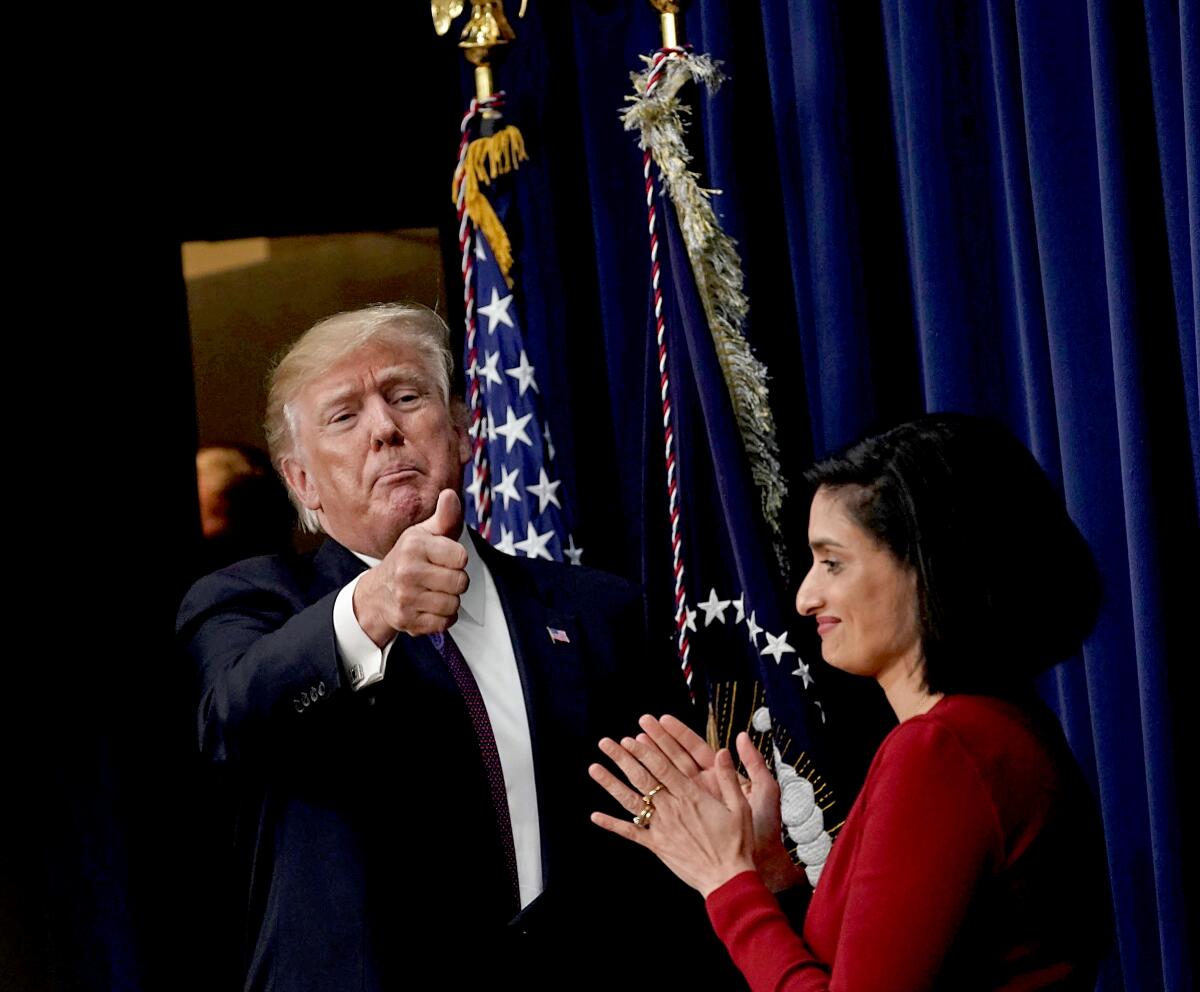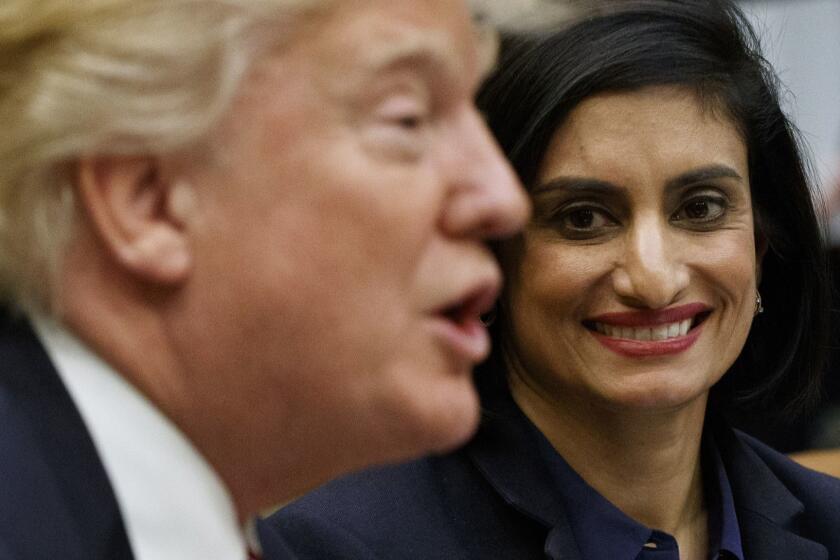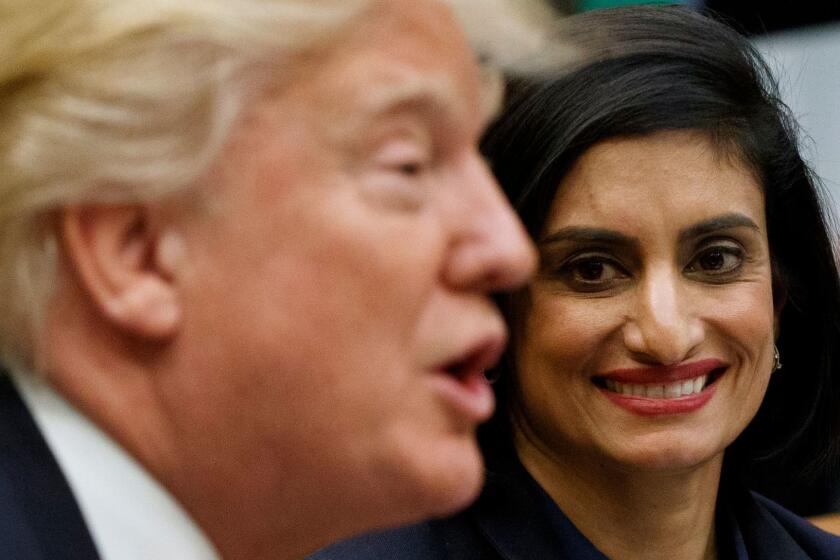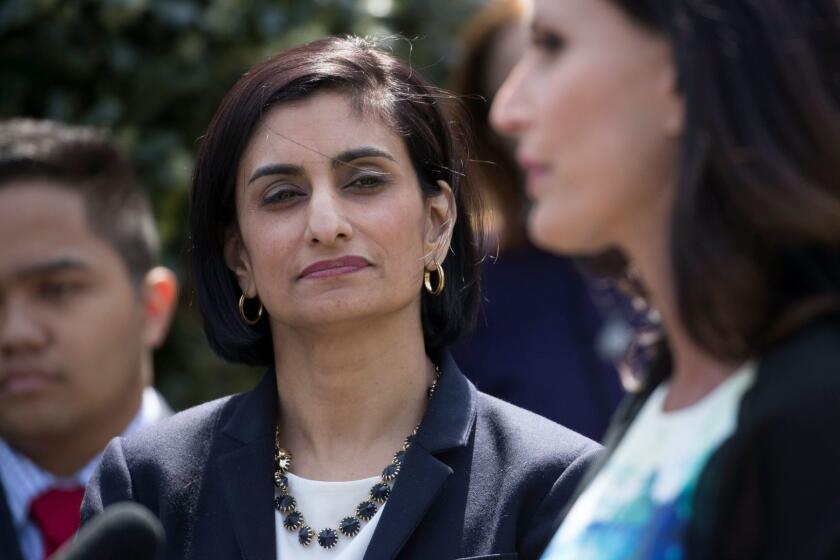Column: Trump makes his most aggressive move yet to gut Medicaid

- Share via
Rebuffed by the courts in its previous efforts to gut Medicaid, the Trump administration teed up a new, far-reaching attack on the program that could affect the health of millions of low-income Americans.
Officially unveiled Thursday under the Orwellian label “Healthy Adult Opportunity,” the new rules would encourage states to cut benefits and narrow eligibility for residents who qualify under the Affordable Care Act’s Medicaid expansion provision.
Although the administration asserted that the rules would give states “new levels of flexibility” in running their Medicaid programs, in fact they would lock them into annual caps for Medicaid that could not be exceeded. In essence, the rules are tantamount to block granting Medicaid — that is, setting a concrete budget — which destroys flexibility.
To many of us, Medicaid is remote.
— Medicaid chief Seema Verma gets the program exactly wrong
As my colleague Noam Levey reports, Medicaid and the related Children’s Health Insurance Program cover more than 70 million low-income Americans. The program’s $600-billion cost is split between the federal government and states.
Medicaid expansion, which broadened the program to childless low-income adults, has been a target of conservatives and Republicans since the ACA was enacted in 2010. It came under attack again Thursday by Medicaid administrator Seema Verma, who asserted at a news conference announcing the proposed changes that the expansion has forced states to place disabled beneficiaries on waiting lists for enrollment. That claim has been debunked by experts.
Whether many states will take up the administration’s offer to remake their Medicaid programs is unclear, in part because the legality of some of the new provisions is uncertain. Medicaid’s financing structure is set by federal law, and Verma and her boss, Health and Human Services Secretary Alex Azar, offered no explanation for “how HHS can make a fundamental change to Medicaid’s financing structure,” Nicholas Bagley of the University of Michigan Law School observed on Twitter.
“That’s going to be a big legal problem for any state rash enough to move ahead with one of these proposals,” Bagley wrote.
Seema Verma, the federal official in charge of Medicare, Medicaid and the Affordable Care Act, has blasted into the limelight. And not in a good way.
The administration’s latest initiative drew immediate fire from Democrats and Medicaid patient advocates. “Today’s announcement is the cruelest step yet by the Trump administration to slash American healthcare and dismantle basic safety net programs,” said Sen. Ron Wyden (D-Ore.). Republican efforts in Congress to convert Medicaid to a block-grant program failed, Wyden observed, “due to an outcry from families across the country over the consequences for children, seniors, individuals with disabilities and the millions of working families who rely on the program for essential health coverage.”
The administration’s announcement Thursday bristled with misrepresentations of Medicaid and its benefits.
“To many of us, Medicaid is remote,” Verma stated. “Most of us are healthy, working and insured, so it seems unlikely to affect our lives directly…. Tragedy and bad luck can strike anyone, at any time. When it does, people need something to fall back on.”
In fact, Medicaid plays a much more important role in American lives. As I’ve reported, the program pays for roughly half of all births in the United States (more than 60% across the South, which remains a nest of anti-expansionism). It covers 62% of all nursing home residents, and it is the largest single source of payment for mental health services.
One-third of all children in the U.S. are enrolled in Medicaid. With 70 million enrollees, the program is the largest single source of medical coverage in the nation — hardly “remote.”
That hasn’t stopped the Trump administration from relentlessly trying to gut Medicaid. Its approval of work requirements for the program in Arkansas and Kentucky was blocked by a federal judge in Washington, prompting other states that were seeking similar approvals to back off. The administration contends that changing Medicaid rules is a critical need because the program is so costly, but that’s a threadbare rationale.
The new Medicaid rules would allow states to impose work requirements or premiums on Medicaid recipients, even though work rules have been overturned in the federal courts. Enrollees could be suspended if they fail to pay required premiums after a grace period, a condition HHS called “consistent with promoting the objectives of the Medicaid program.”
Bagley called that “a particularly galling bit of double-speak,” since throwing enrollees out of Medicaid can hardly be judged “consistent” with a program aimed at signing people up for coverage.
The Trump administration has finally made good on a long-standing threat to undermine Medicaid.
States could radically redesign their Medicaid programs, for example to cover only sufferers from specific conditions, “such as individuals with severe mental illness, individuals needing treatment for substance use disorder, or individuals with HIV/AIDS,” the Centers for Medicare and Medicaid Services said in a letter to state Medicaid directors dated Thursday. States could also reduce the list of drugs available to Medicaid enrollees, even though current rules require access to any drug licensed by the Food and Drug Administration.
States could also impose asset tests on applicants even though asset tests — judgments of whether assets such as an applicant’s home equity or car ownership should make him or her ineligible — are not part of Medicaid expansion rules. And they could eliminate retroactive eligibility, a provision that allows doctors or hospitals to enroll patients on the spot if they appear with a medical emergency and haven’t enrolled even though they’re eligible.
The major change proposed by the administration involves block granting the program. The proposal would allow states to run Medicaid under an “aggregate” cap determined by previous yearly spending, or a per capita limit based on population growth.
With the first option, if states’ spending is lower than the cap, they would be able to pocket some of the savings, though there would be restrictions on how they could spend the bounty. To capture the savings, they would have to spend at least 80% of the cap on Medicaid.
Trump claims enrollees are gaming Medicaid eligibility, but there’s no evidence for the claim.
Under current law, the federal government pays a set percentage of all state Medicaid spending. The match varies by state based on per capita income, with poorer states receiving a larger match. Mississippi, for example, receives more than 75%, California 61.5%. For the Medicaid expansion population, the federal government match is 90% for this year and all future years.
Under those conditions, Medicaid funding can rise or fall with need, responding to unforeseen shocks. As health insurance expert David Anderson of Duke University observed last year, the shocks could be “a major storm like Hurricane Maria in Puerto Rico, they can be mass unemployment like 2008-2009, they can be a new technology like hep[atitis] C cures or they can be a new disease like Zika .... Block grants are not designed to respond to negative shocks.”
The administration told state Medicaid directors that their block grant budgets could be updated “due to unforeseen circumstances out of the state’s control, such as a public health crisis or major economic event.” But the procedure for doing so appears to be burdensome: States would have to submit new data subject to validation in Washington by multiple federal agencies, and renegotiate the cap. Those conditions might well delay a state’s ability to respond to a crisis.
That sounds like exactly what the administration is aiming for. The less that Medicaid can play a role in American healthcare, the easier it will be for Verma to assert that it’s “remote” from people’s lives. But that’s hardly a goal worth pursuing.
More to Read
Inside the business of entertainment
The Wide Shot brings you news, analysis and insights on everything from streaming wars to production — and what it all means for the future.
You may occasionally receive promotional content from the Los Angeles Times.














